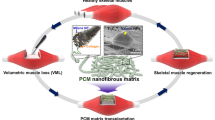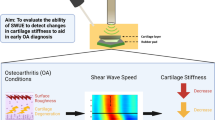Abstract
To examine whether differences in chondrocytes from skeletally immature versus adult individuals are important in cartilage healing, repair, or tissue engineering, superficial zone chondrocytes (SZC, from within 100 μm of the articular surface) and deep zone chondrocytes (DZC, from 30%–45% of the deepest un-mineralized part of articular cartilage) were harvested from immature (1–4 months) and young adult (18–36 months) steers and compared. Cell size, matrix gene expression and protein levels, integrin levels, and chemotactic ability were measured in cells maintained in micromass culture for up to 7 days. Regardless of age, SZC were smaller, had a lower type II to type I collagen gene expression ratio, and higher gene expression of SZ proteins than their DZC counterparts. Regardless of zone, chondrocytes from immature steers had higher levels of Sox 9 and type II collagen gene expression. Over 7 days in culture, the SZC of immature steers had the highest rate of proliferation. Phenotypically, the SZC of immature and adult steers were more stable than their respective DZC. Cell surface α5 and α2 integrin subunit levels were higher in the SZC of immature than of adult steers, whereas β1 integrin subunit levels were similar. Both immature and adult SZC were capable of chemotaxis in response to fetal bovine serum or basic fibroblast growth factor. Our data indicate that articular chondrocytes vary in the different zones of cartilage and with the age of the donor. These differences may be important for cartilage growth, tissue engineering, and/or repair.





Similar content being viewed by others
References
Archer CW, McDowell J, Byliss MT, Stephens MD, Bentley G (1990) Phenotypic modulation in sub-populations of human articular chondrocytes in vitro. J Cell Sci 97:361–371
Aydelotte MB, Kuettner KE (1988) Differences between sub-populations of cultured bovine articular chondrocytes. I. Morphology and cartilage matrix production.Connect Tissue Res 18:205–222
Aydelotte MB, Greenhill RR, Kuettner KE (1988) Differences between sub-populations of cultured bovine articular chondrocytes. II. Proteoglycan metabolism. Connect Tissue Res 18:223–234
Barbero A, Grogan S, Schafer D, Heberer M, Mainil-Varlet P, Martin I (2004) Age related changes in human articular chondrocyte yield, proliferation and post-expansion chondrogenic capacity. Osteoarth Cartil 12:476–484
Bayliss MT, Hutton S, Hayward J, Maciewicz RA (2001) Distribution of aggrecanase (ADAMts 4/5) cleavage products in normal and osteoarthritic human articular cartilage: the influence of age, topography and zone of tissue. Osteoarth Cartil 9:553–560
Bhargava MM, Beavis AJ, Edberg JC, Warren RF, Attia ET, Hannafin JA (1999a) Differential expression of integrin subunits in canine knee ligament fibroblasts. J Orthop Res 17:748–754
Bhargava MM, Attia ET, Murrell GA, Dolan MM, Warren RF, Hannafin JA (1999b) The effect of cytokines on the proliferation and migration of bovine meniscal cells. Am J Sports Med 27:636–643
Billinghurst RC, Dahlberg L, Ionescu M, Reiner A, Bourne R, Rorabeck C, Mitchell P, Hambor J, Diekmann O, Tschesche H, Chen J, Van Wart H, Poole AR (1997) Enhanced cleavage of type II collagen by collagenases in osteoarthritic articular cartilage. J Clin Invest 99:1534–1545
Campbell CJ (1969) The healing of cartilage defects. Clin Orthop 64:45–63
Chang C, Lauffenburger DA, Morales TI (2003) Motile chondrocytes from newborn calf: migration properties and synthesis of collagen II. Osteoarth Cartil 11:603–612
Darling EM, Athanasiou KA (2005) Rapid phenotypic changes in passaged articular chondrocyte subpopulations. J Orthop Res 23:425–432
Darling EM, Hu JC, Athanasiou KA (2004) Zonal and topographical differences in articular cartilage gene expression. J Orthop Res 22:1182–1187
de la Fuente R, Abad JL, Garcia-Castro J, Fernandez-Miguel G, Petriz J, Rubio D, Vicario-Abejon C, Guillen P, Gonzalez MA, Bernad A (2004) Dedifferentiated adult articular chondrocytes: a population of human multipotent primitive cells. Exp Cell Res 297:313–328
Dowthwaite GP, Bishop JC, Redman SN, Khan IM, Rooney P, Evans DJ, Haughton L, Bayram Z, Boyer S, Thomson B, Wolfe MS, Archer CW (2004) The surface of articular cartilage contains a progenitor cell population. J Cell Sci 117:889–897
Eyre DR, Brickley-Parsons DM, Glimcher MJ (1978) Predominance of type I collagen at the surface of avian articular cartilage. FEBS Lett 85:259–263
Farndale R, Buttle D, Barrett A (1986) Improved quantitation and discrimination of sulphated glycosaminoglycans by use of dimethyl-methylene blue. Biochim Biophys Acta 883:173–177
Flannery CR, Hughes CE, Schumacher BL, Tudor D, Aydelotte MB, Kuettner KE, Caterson B (1999) Articular cartilage superficial zone protein (SZP) is homologous to megakaryocyte stimulating factor precursor and is a multifunctional proteoglycan with potential growth-promoting, cytoprotective, and lubricating properties in cartilage metabolism. Biochem Biophys Res Commun 254:535–541
Frenkel SR, Clancy RM, Ricci JL, Di Cesare PE, Rediske JJ, Abramson SB (1996) Effects of nitric oxide on chondrocyte migration, adhesion, and cytoskeletal assembly. Arthritis Rheum 39:1905–1912
Hamerman D, Rosenberg LC, Schubert M (1970) Diarthrodial joints revisited. J Bone Joint Surg Am 52:725–774
Hauselmann HJ, Flechtenmacher J, Michal L, Thonar EJ, Shinmei M, Kuettner KE, Aydelotte MB (1996) The superficial layer of human articular cartilage is more susceptible to interleukin-1-induced damage than the deeper layers. Arthritis Rheum 39:478–488
Hayes AJ, MacPherson S, Morrison H, Dowthwaite G, Archer CW (2001) The development of articular cartilage: evidence for an appositional growth mechanism. Anat Embryol (Berl) 203:469–479
Hunziker EB (2002) Articular cartilage repair: basic science and clinical progress. A review of the current status and prospects. Osteoarth Cartil 10:432–63. Review
Kim TK, Sharma B, Williams CG, Ruffner MA, Malik A, McFarland EG, Elisseeff JH (2003) Experimental model for cartilage tissue engineering to regenerate the zonal organization of articular cartilage. Osteoarth Cartil 11:653–664
Klein TJ, Schumacher BL, Schmidt TA, Li KW, Voegtline MS, Masuda K, Thonar EJ, Sah RL (2003) Tissue engineering of stratified articular cartilage from chondrocyte subpopulations. Osteoarth Cartil 11:595–602
Kolettas E, Muir HI, Barrett JC, Hardingham TE (2001) Chondrocyte phenotype and cell survival are regulated by culture conditions and by specific cytokines through the expression of Sox-9 transcription factor. Rheumatology (Oxford) 40:1146–1156
Kuettner KE, Aydelotte MB, Thonar EJ (1991) Articular cartilage matrix and structure: a minireview. J Rheumatol Suppl 27:46–48
Lefebvre V, Behringer RR, de Crombrugghe B (2001) L-Sox5, Sox6 and Sox9 control essential steps of the chondrocyte differentiation pathway. Osteoarth Cartil 9 (Suppl A):S69–S75
Lucchinetti E, Bhargava MM, Torzilli PA (2004) The effect of mechanical load on integrin subunits alpha5 and beta1 in chondrocytes from mature and immature cartilage explants. Cell Tissue Res 315:385–391
Mankin HJ (1964) Mitosis in articular cartilage of immature rabbits. A histologic, stathmokinetic (colchicine) and autoradiographic study. Clin Orthop 34:170–183
Marlovits S, Tichy B, Truppe M, Gruber D, Vecsei V (2003) Chondrogenesis of aged human articular cartilage in a scaffold-free bioreactor. Tissue Eng 9:1215–1226
Marlovits S, Hombauer M, Truppe M, Vecsei V, Schlegel W (2004) Changes in the ratio of type-I and type-II collagen expression during monolayer culture of human chondrocytes. J Bone Joint Surg Br 86:286–95
Martin JA, Buckwalter JA (2003) The role of chondrocyte senescence in the pathogenesis of osteoarthritis and in limiting cartilage repair. J Bone Joint Surg 85(A-Supplement 2):106–110
Mitchell PG, Magna HA, Reeves LM, Lopresti-Morrow LL, Yocum SA, Rosner PJ, Geoghegan KF, Hambor JE (1996) Cloning, expression, and type II collagenolytic activity of matrix metalloproteinase-13 from human osteoarthritic cartilage. J Clin Invest 97:761–768
Moldovan F, Pelletier JP, Hambor J, Cloutier JM, Martel-Pelletier J (1997) Collagenase-3 (matrix metalloprotease 13) is preferentially localized in the deep layer of human arthritic cartilage in situ: in vitro mimicking effect by transforming growth factor beta. Arthritis Rheum 40:1653–1661
Morrison EH, Ferguson MW, Bayliss MT, Archer CW (1996) The development of articular cartilage. I. The spatial and temporal patterns of collagen types. J Anat 189(Pt 1):9–22
Namba RS, Meuli M, Sullivan KM, Le AX, Adzick NS (1998) Spontaneous repair of superficial defects in articular cartilage in a fetal lamb model. J Bone Joint Surg Am 80:4–10
Reid DL, Aydelotte MB, Mollenhauer J (2000) Cell attachment, collagen binding, and receptor analysis on bovine articular chondrocytes. J Orthop Res 18:364–373
Schmidt TA, Schumacher BL, Klein TJ, Voegtline MS, Sah RL (2004) Synthesis of proteoglycan 4 by chondrocyte subpopulations in cartilage explants, monolayer cultures, and resurfaced cartilage cultures. Arthritis Rheum 50:2849–2857
Schumacher BL, Block JA, Schmid TM, Aydelotte MB, Kuettner KE (1994) A novel proteoglycan synthesized and secreted by chondrocytes of the superficial zone of articular cartilage. Arch Biochem Biophys 311:144–152
Shimizu M, Minakuchi K, Kaji S, Koga J (1997) Chondrocyte migration to fibronectin, type I collagen, and type II collagen. Cell Struct Funct 22:309–315
Siczkowski M, Watt FM (1990) Subpopulations of chondrocytes from different zones of pig articular cartilage. Isolation, growth and proteoglycan synthesis in culture. J Cell Sci 97:349–360
Sumi M, Maeda M, Cooke TD (1986) Deleterious interactions of immune complexes with tibial cartilage of antigen-induced arthritic rabbits. II. Chondrocyte degradation. Clin Orthop 212:260–274
Takagi T, Takahashi S, Koshino T, Okamoto R, Jasin HE (1998) Isolation and differential secretion of metalloproteinase by superficial chondrocytes in articular cartilage. Int Orthop 22:55–58
Waldman SD, Grynpas MD, Pilliar RM, Kandel RA (2003) The use of specific chondrocyte populations to modulate the properties of tissue-engineered cartilage. J Orthop Res 1:132–138
Wei X, Messner K (1997) Maturation-dependent repair of untreated osteochondral defects in the rabbit knee joint. J Biomed Mater Res 34:63–72
Wei X, Messner K (1999) Maturation-dependent durability of spontaneous cartilage repair in rabbit knee joint. J Biomed Mater Res 46:539–548
Zanetti M, Ratcliffe A, Watt FM (1985) Two subpopulations of differentiated chondrocytes identified with a monoclonal antibody to keratan sulfate. J Cell Biol 101:53–59
Zlabinger GJ, Menzel JE, Steffen C (1986) Change in collagen synthesis of human chondrocyte culture. I. Development of a human model, demonstration of collagen type conversion by immunofluorescence. Rheumatol Int 6:63–68
Acknowledgements
We thank Dr. Margaret Aydelotte for providing expert consultation on the isolation of zonal sub-populations of chondrocytes and for reviewing this manuscript. We also thank Dr. Margaret Peterson for her assistance with the statistical analyses, Dr. Sergei Rudchenko for his assistance with flow cytometry, and Erik Attia for his technical assistance.
Author information
Authors and Affiliations
Corresponding author
Additional information
This work was supported in part by the National Chapter of the Arthritis Foundation, the Ira DeCamp Fellowship for Musculoskeletal Research of the Hospital for Special Surgery, the Institute for Sports Medicine Research in New York, and the National Institute of Health grant AR045748 and was conducted in a facility constructed with support from the Research Facilities Improvement Program (grant no. C06-RR12538-01) of the National Center for Research Resources, National Institutes of Health.
Rights and permissions
About this article
Cite this article
Hidaka, C., Cheng, C., Alexandre, D. et al. Maturational differences in superficial and deep zone articular chondrocytes. Cell Tissue Res 323, 127–135 (2006). https://doi.org/10.1007/s00441-005-0050-y
Received:
Accepted:
Published:
Issue Date:
DOI: https://doi.org/10.1007/s00441-005-0050-y




